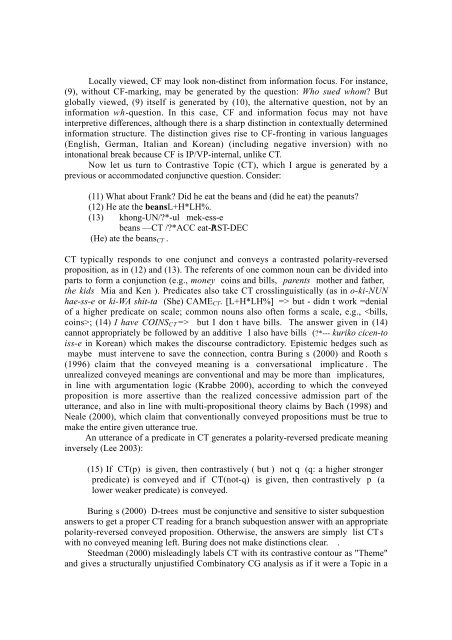SemPrag03.Progr.pdf - Institut für Linguistik/Germanistik - Universität ...
SemPrag03.Progr.pdf - Institut für Linguistik/Germanistik - Universität ...
SemPrag03.Progr.pdf - Institut für Linguistik/Germanistik - Universität ...
You also want an ePaper? Increase the reach of your titles
YUMPU automatically turns print PDFs into web optimized ePapers that Google loves.
Locally viewed, CF may look non-distinct from information focus. For instance,<br />
(9), without CF-marking, may be generated by the question: Who sued whom? But<br />
globally viewed, (9) itself is generated by (10), the alternative question, not by an<br />
information wh-question. In this case, CF and information focus may not have<br />
interpretive differences, although there is a sharp distinction in contextually determined<br />
information structure. The distinction gives rise to CF-fronting in various languages<br />
(English, German, Italian and Korean) (including negative inversion) with no<br />
intonational break because CF is IP/VP-internal, unlike CT.<br />
Now let us turn to Contrastive Topic (CT), which I argue is generated by a<br />
previous or accommodated conjunctive question. Consider:<br />
(11) What about Frank? Did he eat the beans and (did he eat) the peanuts?<br />
(12) He ate the beansL+H*LH%.<br />
(13) khong-UN/?*-ul mek-ess-e<br />
beans —CT /?*ACC eat-PAST-DEC<br />
(He) ate the beans CT .<br />
CT typically responds to one conjunct and conveys a contrasted polarity-reversed<br />
proposition, as in (12) and (13). The referents of one common noun can be divided into<br />
parts to form a conjunction (e.g., money coins and bills, parents mother and father,<br />
the kids Mia and Ken ). Predicates also take CT crosslinguistically (as in o-ki-NUN<br />
hae-ss-e or ki-WA shit-ta (She) CAME CT . [L+H*LH%] => but - didn t work =denial<br />
of a higher predicate on scale; common nouns also often forms a scale, e.g., ; (14) I have COINS CT => but I don t have bills. The answer given in (14)<br />
cannot appropriately be followed by an additive I also have bills (?*--- kuriko cicen-to<br />
iss-e in Korean) which makes the discourse contradictory. Epistemic hedges such as<br />
maybe must intervene to save the connection, contra Buring s (2000) and Rooth s<br />
(1996) claim that the conveyed meaning is a conversational implicature . The<br />
unrealized conveyed meanings are conventional and may be more than implicatures,<br />
in line with argumentation logic (Krabbe 2000), according to which the conveyed<br />
proposition is more assertive than the realized concessive admission part of the<br />
utterance, and also in line with multi-propositional theory claims by Bach (1998) and<br />
Neale (2000), which claim that conventionally conveyed propositions must be true to<br />
make the entire given utterance true.<br />
An utterance of a predicate in CT generates a polarity-reversed predicate meaning<br />
inversely (Lee 2003):<br />
(15) If CT(p) is given, then contrastively ( but ) not q (q: a higher stronger<br />
predicate) is conveyed and if CT(not-q) is given, then contrastively p (a<br />
lower weaker predicate) is conveyed.<br />
Buring s (2000) D-trees must be conjunctive and sensitive to sister subquestion<br />
answers to get a proper CT reading for a branch subquestion answer with an appropriate<br />
polarity-reversed conveyed proposition. Otherwise, the answers are simply list CTs<br />
with no conveyed meaning left. Buring does not make distinctions clear. .<br />
Steedman (2000) misleadingly labels CT with its contrastive contour as "Theme"<br />
and gives a structurally unjustified Combinatory CG analysis as if it were a Topic in a

















